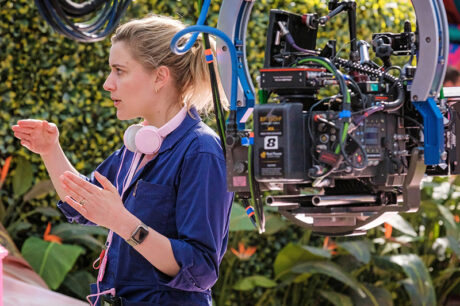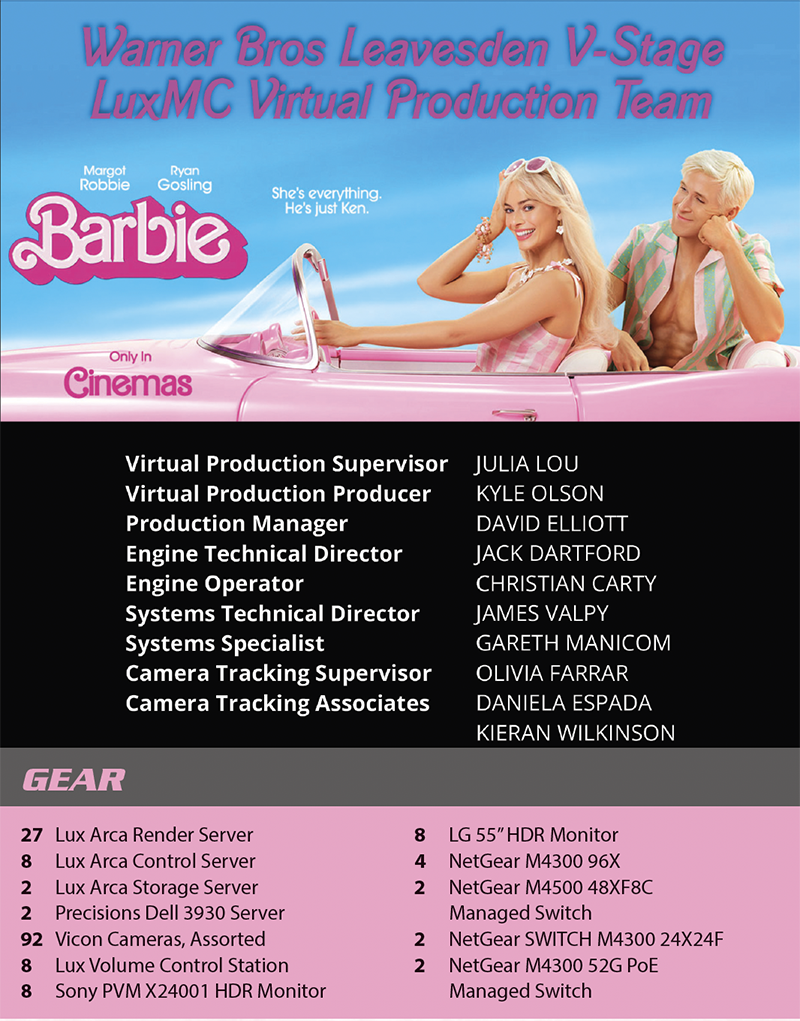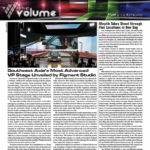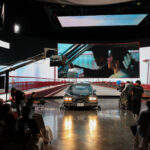
Lux Machina Renders Visual Effects for Barbie
For the blockbuster movie, Barbie, which is setting—and breaking—box office records, virtual production was deployed in the creative process. In the marketing of the movie and in interviews with Director Greta Gerwig and Production Designer, Sarah Greenwood, and Set Decorator Katie Spencer, much has been made of using traditional techniques and building real, practical sets. But while Barbie’s dream house was a beautifully, and rightly lauded, constructed set, there was still a lot of virtual production done on this movie, which has upwards of 1,000 visual effects (VFX) shots produced for the film.
Phil Galler, President of Lux Machina and Prysm, which are part of NEP, spoke with PLSN about the visual effects his company helped support and produce for the film. He shared some insight into the virtual production and VFX workflows and processes that helped bring Barbie’s journey to life.
For Barbie, there is an interesting mix of new virtual production and visual effects and practical, actually built scenic and set elements. “Yes, there are definitely lots of practical elements in the set for sure,” states Galler,” in fact, there are a lot of shots where they captured a lot in-camera. There’s some marketing confusion saying that there were no VFX for this movie. It was a heavily VFX movie, as well as there was a lot shot practically. Also, there was quite a bit done with virtual production as a tool to actually reduce the amount of visual effects, which worked really well. There are upwards of 1,000 VFX shots in this movie.” Often a lot of what is shot in-camera still needs touching up in VFX. Galler says it is similar to other unnamed films that the press all push that everything was done all practically with no VFX, yet when you speak with the VFX companies on the same film, they will have worked on thousands of VFX shots at the end of the day.
Sunrise Shots
“Barbie was shot at Warner Bros. Studios Leavesden’s virtual production stage, called, ‘V Stage,’” says Galler. Located in Hertfordshire England, V Stage originally opened with the production of House of the Dragon, HBO’s prequel to Game of Thrones, which Lux Machina also supported. Leavesden’s V Stage, is one of the largest in Europe, with 24,000 sq. ft. of total space, and a 7,100 sq. ft. virtual production environment. “Visual effects company, Framestore built many of the environments for Barbie,” explains Galler. “Many of the sunsets were all virtual environments. They did something really cool; they built what I refer to as ‘Barbie World Pink Town’ in Unreal. We used it for previz as well as for reflection assets in a whole range of the shootings. They would come into the stage and set up a variety of shots that used the LED wall to frame up where they were going to eventually put larger CG assets. Some of that work made it into the movie. A lot of it got replaced in post, which was the plan the whole time, which was great. Then, a bunch of the sunsets in the beginning of the movie, and some of the film’s trailers you see she’s in front of a nice sunset. That was all LED that worked really well. It was a long shoot—two or three months on stage, but it was a good experience for them to be able to repeat a whole bunch of action and animation and dialogue.”
Consistent Lighting
The film has a very specific lighting style for Barbie’s world, where there’s a very consistent light the entire time in her world. This helps to underpin the artificial nature of the doll’s world. The lighting doesn’t change to realistic until Barbie and Ken travel outside of Barbie’s world into the real one. It’s been described as similar to the flat lighting that was ever present in Peter Weir’s film, Truman Show, where the world was all fake and only superficially resembled the real world. “Getting that consistent light requires a lot of onstage work and Barbie looks a certain way because of that attention to the lighting. You have to have that as a scene throughout the piece to maintain that. It’s a lot easier to do it on stage and give people the appropriate visual cues and environments to react to. I think it worked really well.”
Build a Tool
Lux Machina has been building its own media servers—the Lux Arca Server—and supplied a large quantity to the production. “This is the third WB project to use the Lux Arca Servers,” explains Galler. “It was first on House of The Dragon. On Barbie, we used about 40 Lux Arcas all driving Unreal Engine paired with a Vicon camera tracking system. There were almost 100 motion capture tracking cameras for this film. It’s a couple of thousands of tiles of ROE [Visual] Black Pearl and CB5 LED panels for the LED volume. It was massive. Our machine rooms were pretty complex with lots of image processing, then we built out custom control stations that run some of our own software. It’s like an enterprise-scale KVM solution.” The main function of a KVM [Keyboard, Video (monitor), Mouse] switch is to control, switch between, and manage multiple PCs or servers via a single keyboard, monitor, and mouse. Some people also refer to as the ‘console.’
The Lux Machina team onsite at Leavesden’s V Stage worked directly with the VFX team, that was led by Visual Effects Supervisor Glen Pratt, “as well as a little bit with Director Greta Gerwig from a directorial point of view,” says Galler. “As I said, Framestore also did visual effects; they were a double vendor, and it was nice to work with them to have that consistency. For Warner Bros., we worked with Ryan Beagan, Senior VP of Virtual Production, and the in-house virtual production staff. That was, is, a really good relationship also.”

Interesting to See
When asked how it feels to have worked on one of the highest grossing films of the year, Galler responds, “It’s cool and actually, really interesting. The cultural phenomena, I think, is really fascinating because it’s a double-sided coin. You want these movies to go on and be really great, but as the marketing gets going, you also want people to acknowledge that some of your work is involved in it. The bigger it gets, the more coverage and stories are written about it, the more people keep going with the idea that, ‘There’s no VFX in it,’ which is weird, because you’re like, ‘No, wait a second. There’s lots of work, by a ton of people, in those images.’ It feels good to be involved with such a successful film. Of course, it’s now WB’s biggest movie, which is pretty exciting and hopefully, this film creates a renaissance, when the strikes are over, for new movies that can push the boundaries of both progressive communications, but also interesting storylines and slightly different ways of telling stories. Hopefully, this is a new way of being able to explore those ideas. I think it’s maybe also a heralding of the fact that people are willing to go back to the movie theaters to some extent.”
Galler doesn’t think movie theater attendance will ever be the way it was 20 years ago, “but I think to some extent, this shows that people will come if the right movies can attract those people to theaters. You look at Oppenheimer and it’s the same way. People who don’t usually go to movie theaters are suddenly going to movie theaters. To me, it’s interesting and it’ll be interesting to see what Warner Bros., and other studios, do. I imagine that it took some convincing to get Barbie green lit just because it doesn’t seem like it would be anything more than a child’s tale at some level if you’re sitting in a boardroom,” comments Galler. “I am fascinated to see what doors it has opened in terms of making films of other IP and other properties. I think there could be a ton of movies that come out of this that tell really interesting stories. I think that could be really cool.”

Lux Machina’s Lux Arca Media Server
The media servers used to feed the content to the LED volume and support the virtual production workflow for Barbie are Lux Machina’s own Lux Arca Servers. As a leader in the development of virtual production solutions, Lux Machina needed a more robust and flexible media server than they were finding out on the market, so they created their own. Here’s an overview of some of this server’s features and benefits.
Designed in house specifically for the real-time workflows of virtual production, the Lux Arca Server is designed to be affordable, works seamlessly with Epic’s Unreal Engine, and comes completely unlocked, so you can use it how you see fir for your productions. The server comes packaged with a quad license of PIXERA, so users get a full-fledged media server software solution alongside Lux Machina’s fully optimized real-time hardware.
The Lux Arca Servers have a one-year out-of-the-box warranty with the option to extend for another year. If service and support is needed, Lux Machina has a dedicated service number to call if there are any issues. As an add-on, Lux Machina also offers turn-key services with the installation and operations of the Lux Arca system.
The Lux Arca have been tried—and proven—on a range of film and broadcast productions including HBO’s House of The Dragon, Warner Bros. Barbie, and via sister company Prysm, under the NEP umbrella of companies, it was used on the recently wrapped Francis Ford Coppola film, Megalopolis, which shot in Atlanta, GA at Trillith Studios. Notable Lux Arca clients include Sony Pictures, Warner Bros. Studios, HBO, Amazon Studios, and Apple Studios. Specialty stages at Nant Studios and Epic Games are also Lux Arca users. Further information on the Lux Arca Servers is available on Lux Machina’s web site at www.luxmc.com.
Lux Arca Server Features
- CPU: AMD ThreadRipper Pro 32 Core
- RAM: 256GB
- Chassis: Rackmount 4RU Stabilized Chassis
- HDD: 3 x 2TB NVME
- GPU: Dual A6000 w/ Quadro Sync
- Capture Card: Multi-channel 4K/UHD
- Network: dual 1-gbe connectx card
- Cooling: Liquid Cooled CPU with Additional Active Air Cooling
- Operating System: Windows 10 Pro for Workstations
- Additional Software: Pixera Quad Output Media Server License


